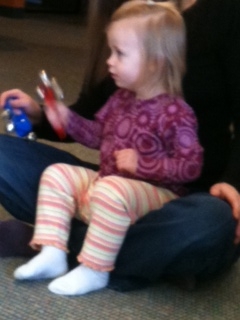The rhythm instruments are placed on the floor. Some scramble to get them, others sneak up slowly to lay claim on a set for themselves. It is time for play-a-long.
Susie Q looks carefully at her instrument. She turns it around in her hand. Since she is younger the impulse to put it in her mouth is strong. Exploration always comes first. She may, or may not, feel the steady beat coming from the music.Some children feel an internal beat but will not be able to match that with the group.Whether they are bells, shakers, or sandblocks, keeping a beat in a group is very stimulating.
Sandblocks are ideal because children are bi-lateral in their movements. It is natural for them to move both hands together. Having two instruments the door opens for the element of sound. What do the sandblocks sound like rubbed together? What happens if we turn them over and tap the knobs on each other?
How does the sound change if the bells on on my arm or if I hit them on the floor?
Parents and caregivers can be models by showing and making a steady beat,
Parents and caregivers can be models by showing and making a steady beat,
What do these instruments feel like? Are they smooth or rough?
Then of course clean-up time comes. We sing, clean-up, clean-up, everybody, everywhere. Here is an opportunity to teach respect for the instruments by learning to put them away carefully. Some children cannot be separated from the source of their exploration but in time other activities take their focus away and the instrument is forgotten. Someday these children may play in an ensemble and this will be a foundational experience.
Thank-you for playing on the floor with us,
Thank-you for playing on the floor with us,







No comments:
Post a Comment
What do you think?